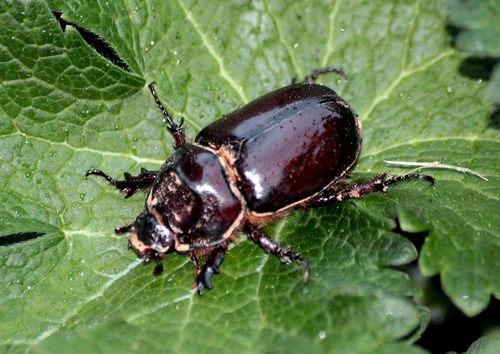European rhinoceros beetle Oryctes nasicornis found in Martley
Angie Hill.
Compiled by Harry Green, editor Worcestershire Record
In August 2013 great excitment erupted in the local Worcestershire press and on local radio because Angie Hill found a European Rhinoceros beetle Oryctes nasicornis in Martley. She sent pictures to Danny Arnold of the Teme Valley Wildlife Group and the beetle appeared on their web site www.temevalleywildlife.com. The story was also taken up nationally and the finder mentioned it to Buglife. She emailed Danny as follows:
“Well, I had a phone call from Buglife today and it's now official! I have the one and only true record of a Rhinoceros beetle in the UK ever! Although archives state that a dead one was found by a builder among old timber in Chelsea in 1836, the true identity wasn't confirmed at the time. No other records exist. It is fairly common on the continent as far north as Scandinavia, so it is obviously tolerant of cold winters”.
Later in an emails exchange with the editor she wrote:
“I found the female beetle early one morning while checking my moth trap [in my garden]. I noticed it on the leaf of a hardy geranium, near to the trap. I photographed it. I had never seen a beetle as big as that. I initially thought it was a female Stag beetle of some sort. I attended the Rutland Birdfair two weeks later, and while I was on the Buglife stand, I mentioned it to them. They asked me to send a photo, which I duly did. They phoned me back very excited saying it had been identified as a newly emerged female Rhinoceros beetle. They wanted confirmation, so forwarded my photo to two specialists at Oxford University. It was confirmed last week.
“I have never seen one before, and have not seen this individual since. I am hoping that it is not an isolated case, but rather expect that it might well be”.
Your editor had raised the possibility that the beetle had been accidentally imported from Europe hidden amongst garden plants, olive tree stumps, sawdust or similar materials. Angie replied:
“I have a lot of old rotting wood & sawdust in the garden (used as a mulch etc) and various log piles (only from the woodland opposite).mainly of Ash, Willow and Poplar). My garden is not tidy, and is indeed rather wild. Hillend Sawmills is just up the road so it is possible that is where it originated. Martley is a rural-ish village and I doubt anyone round here would have an imported olive stump in their garden. As for bringing it back from a holiday who knows? What I will do is write a short piece for our local Village magazine, asking for people to look out for large beetles like this. I shall also ask around regarding any budding entomologists out there who might have reared one and let it go, accidentally or otherwise.
“Whether this is a one-off due to the beetle having been imported accidentally, or is indeed the beginnings of a small colony here in Worcestershire, who knows? I have to say I find it rather exciting, don't you?”
In an earlier email your editor had written to Danny Arnold:
“I guess somebody in or near Martley rears exotic beasts and they escape at times or are released or Taylors lorries brought stuff back in the recent past [we have received odd records of reptiles from Martley in the past]. It is very interesting to record these things in case they become established but I very much doubt whether the beetle is a true native”. But who knows? Well worth keeping a look out for very large beetles in or near Martley.
Images
01. European rhinoceros beetle Oryctes nasicornis in Martley. Angie Hill
